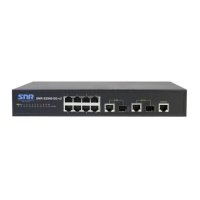SNR S2940-8G-v2 Switch Configuration Guide
IPv4 Multicast Protocol
IANA (Internet Assigned Number Authority) that the higher 25 bits in Multicast MAC address is
0x01005e, and the lower 23bits in MAC address is the lower 23bits in Multicast IP address.
Since only 23bits out of the lower 28bits in IP Multicast address are mapped into MAC address,
therefore there are 32 IP Multicast addresses which are mapped into the same MAC address.
40.1.3 IP Multicast Packet Transmission
In Multicast mode, the source host sends packets to the host group indicated by the Multicast
group address in the destination address field of IP data packet. Unlike Unicast mode, Multi-
cast data packet must be forwarded to a number of external interfaces to be sent to all receiver
sites in Multicast mode, thus Multicast transmission procedure is more complicated than Unicast
transmission procedure.
In order to guarantee that all Multicast packets get to the router via the shortest path, the
receipt interface of the Multicast packet must be checked in some certain way based on Unicast
router table; this checking mechanism is the basis for most Multicast Routing Protocol to forward
in Multicast mode --- RPF (Reverse Path Forwarding) check. Multicast router makes use of the
impressed packet source address to query Unicast Router Table or independent Multicast Router
Table to determine if the packet ingress interface is on the shortest path from receipt site to source
address. If shortest path Tree is used, then the source address is the address of source host which
sends Multicast Data Packets; if Shared Tree is used, then the source address is the address of
the root of the Shared-Tree. When Multicast data packet gets to the router, if RPF check passes,
then the data packet is forwarded according to Multicast forward item, and the data packet will be
discarded else wise.
40.1.4 IP Multicast Application
IP Multicast technology has effectively solved the problem of sending in single point and receiving
in multipoint. It has achieved the effective data transmission from a point to multiple points, saved a
great deal of network bandwidth and reduced network load. Making use of the Multicast property of
network, some new value-added operations can be supplied conveniently. In Information Service
areas such as online living broadcast, network TV, remote education, remote medicine, real time
video/audio meeting, the following applications may be supplied:
1. Application of Multimedia and Streaming Media
2. Data repository, finance application (stock) etc
3. Any data distribution application of 'one point to multiple points'
In the situation of more and more multimedia operations in IP network, Multicast has tremen-
dous market potential and Multicast operation will be generalized and popularized.
40.2 DCSCM
40.2.1 Introduction to DCSCM
DCSCM (Destination control and source control multicast) technology mainly includes three as-
pects, i.e. Multicast Packet Source Controllable, Multicast User Controllable and Service-Oriented
260

